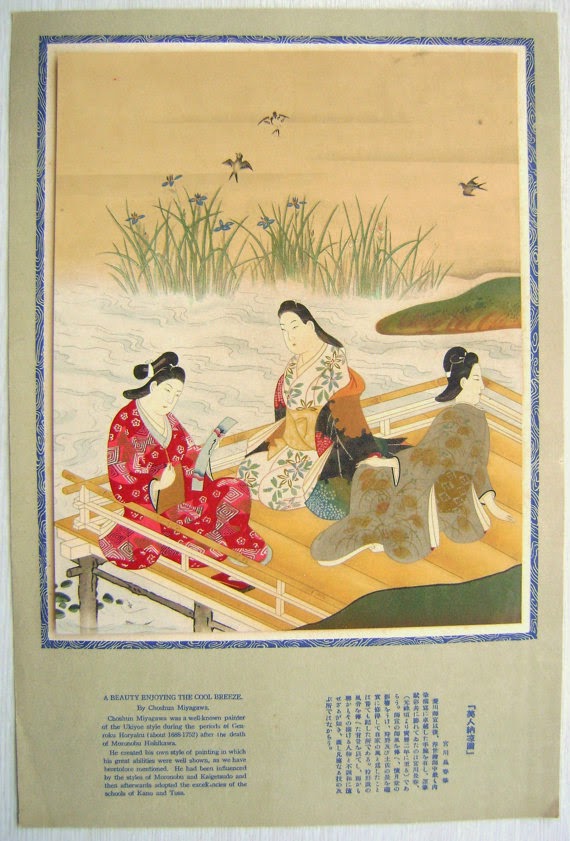I absolutely love the bags that women carry when they wear a kimono. This one is beautiful! It is gold and it sparkles a lot! There are flowers and swirls of gold which are to represent flowing water.
Wednesday, September 24, 2014
Monday, September 22, 2014
Vintage Japanese Lotus Root Kashigata Sugar Cake Mold
This is a vintage sugar cake mold called "kashigata". This is a
beautiful Japanese vintage wood sweets mold. It is lotus root.
Kashigata was used in the making of wagashi (nama-gashi or freshly made
cake and hi-gashi or dried confectionery) for tea ceremonies.
This is in the shape of a lotus root.
Often made of sakura (cherry wood) and seasoned for about 3 years before carving, kashigata were used to make dried confectionery made of rice flour and sugar called rakugan. Earliest records show that this practice dates back to the mid-17th century. These confections were used as offerings and snacks for celebratory occasions and even unfortunate events. For example when a person died, it was expensive to give flowers or fresh food so, people made these sweets in the form of flowers, fish etc. These items were then placed on the "butsudan" (family shrine found in the house) for the dead person.
Common kashigata motifs in the Edo era - chrysanthemums, plum blossoms
Meiji Era - spread of western technology - balloons, planes
World War II - national pride heightened - cherry blossoms, battleships - used as gifts for departing troops, ceremonies and commemorative occasions
With the advent of refrigeration, fresh fish replaced rakugan motifs like the sea bream. Sadly today, making offerings for fortunate and unfortunate events is no longer a common practice. This in turn has lessened rakugan demand although they are still found in tea ceremonies and homes. The decrease in kashigata artisans today has made kashigata carving a dying craft making kashigata itself a sought-after collectible.
Often made of sakura (cherry wood) and seasoned for about 3 years before carving, kashigata were used to make dried confectionery made of rice flour and sugar called rakugan. Earliest records show that this practice dates back to the mid-17th century. These confections were used as offerings and snacks for celebratory occasions and even unfortunate events. For example when a person died, it was expensive to give flowers or fresh food so, people made these sweets in the form of flowers, fish etc. These items were then placed on the "butsudan" (family shrine found in the house) for the dead person.
Common kashigata motifs in the Edo era - chrysanthemums, plum blossoms
Meiji Era - spread of western technology - balloons, planes
World War II - national pride heightened - cherry blossoms, battleships - used as gifts for departing troops, ceremonies and commemorative occasions
With the advent of refrigeration, fresh fish replaced rakugan motifs like the sea bream. Sadly today, making offerings for fortunate and unfortunate events is no longer a common practice. This in turn has lessened rakugan demand although they are still found in tea ceremonies and homes. The decrease in kashigata artisans today has made kashigata carving a dying craft making kashigata itself a sought-after collectible.
Sunday, September 21, 2014
Vintage Japanese Print Beauties Enjoying the Cool Breeze by Choshum Miyagawa
We were lucky enough to come across a huge collection of papers, prints,
magazine cut outs, newspaper clippings and more. This was someone's life
long hobby and wow.....there are some very cool items! You can see it here.
It is a print (not original). It is called "A Beauty Enjoying the Cool Breeze" by Choshum Miyagawa.
In this print 3 beautiful women are at the riverside enjoying the cool breeze and one of them is writing a poem about it.
Miyagawa Chōshun (1683 – 18 December 1753) was a Japanese painter in the ukiyo-e style. Founder of the Miyagawa school, he and his pupils are among the few ukiyo-e artists to have never created woodblock prints. He was born in Miyagawa, in Owari province, but lived much of his later life in Edo, where he died.
It is a print (not original). It is called "A Beauty Enjoying the Cool Breeze" by Choshum Miyagawa.
In this print 3 beautiful women are at the riverside enjoying the cool breeze and one of them is writing a poem about it.
Miyagawa Chōshun (1683 – 18 December 1753) was a Japanese painter in the ukiyo-e style. Founder of the Miyagawa school, he and his pupils are among the few ukiyo-e artists to have never created woodblock prints. He was born in Miyagawa, in Owari province, but lived much of his later life in Edo, where he died.
Saturday, September 20, 2014
Zori Traditional Shoes Worn With Kimono
We recently started selling vintage zori and we have received a few questions about the size and how they are worn.
First, let me say that zori are gorgeous!! These are traditionally worn with kimono. The way zori are worn is very different than how sandals are worn in the Western world. Zori are often smaller and narrow than feet. The feet will hang over the side of the shoe and over the back. The reason the feet hang over the side is due to the fact that the thong
part of the shoe is always in the center at the front (unlike flip
flops where the thong is to the side). That is not only the proper way to wear them but also considered "iki" which means "chic, stylish".
These zori are silver with an interesting pattern-reminds me of long grass. They can be seen here in my store.
These zori are silver and pink. You can see them here.
These are so pretty! It was so hard to take pictures because they are very shiny! They are silver with lots of soft pink flowers. You can see them here.
These are lovely and are from 1974. They are in fabulous shape and the colors are amazing!
Subscribe to:
Comments (Atom)











